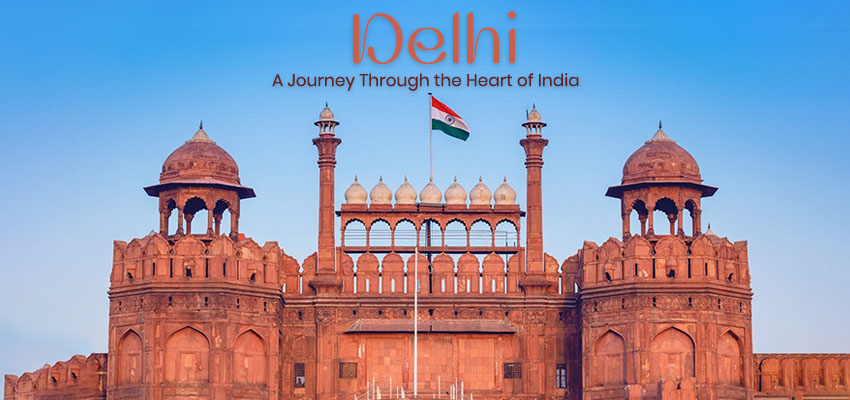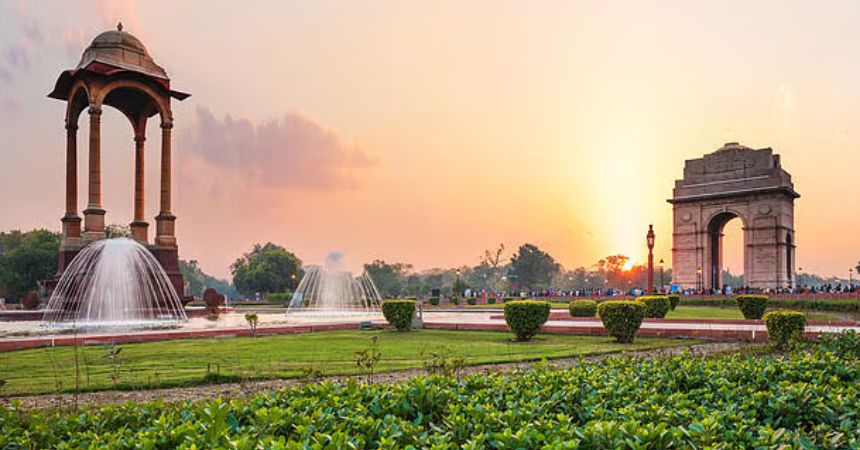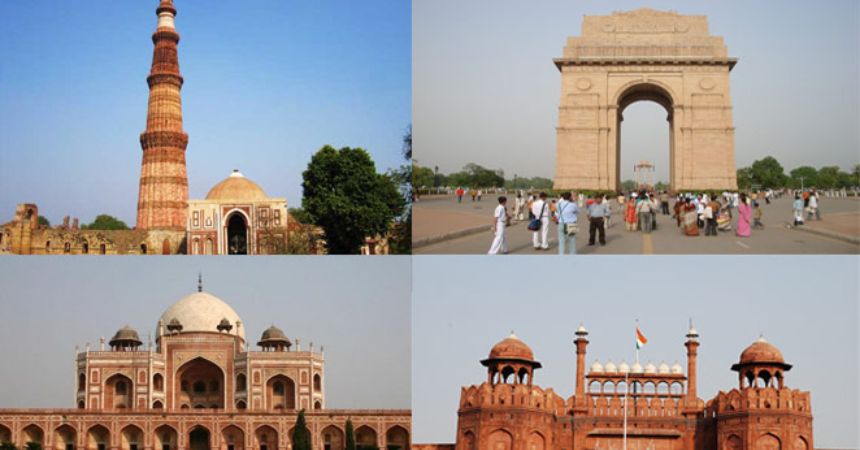Delhi: A Journey Through the Heart of India

As India's capital city Delhi stands as an entrancing destination for travelers who want to discover regional history and experience the nation's dynamic culture and modern energy. Explorers around the world find Delhi deeply intriguing due to its strong connection with India's historical roots when observed alongside present-day political, cultural, and economic conditions. Delhi stands out because of its blend of historic landmarks together with lively bazaars and an evolving modern cityscape. The city offers a singular travel experience that appeals to all kinds of visitors.
The Significance of Delhi
Delhi represents India's political center while also being its cultural and economic hub and serving as the nation's capital. Powerful influence has flowed from this city continuously for a millennium of history. Delhi served as the capital for multiple empires including the Delhi Sultanate, the Mughal Empire, and the British Raj for many centuries and each empire left its unique architectural legacy in the city's forts and mosques as well as European-style buildings. Delhi is the center of Indian government buildings: India's central government operates from Parliament House, Rashtrapati Bhavan which serves as the President's House and India Gate. Delhi plays a vital role in directing India's national policy-making while attracting tourists interested in the nation's political scene. The city serves as a cultural melting pot because it provides refuge to people across India while these diverse populations have shaped local food traditions and festivals.
Tourism in Delhi: A Blend of History and Modernity
 Delhi is a rewarding destination for domestic and international tourists alike. The city has different experiences to offer, from historic sites to lively street bazaars, besides an ever-changing skyline of glass buildings and modern infrastructure. In its tricky combination of old values and modern-day structures, Delhi stands out as a thorough mix of experiences that can provide its visitors with what often seems like a snapshot of India's traditions married to modernity.
In terms of the economy, it is tourism that acts as a backbone for the growing economy of Delhi. The city attracts numerous tourists throughout the year, where they can experience the brilliant Indian architectural wonders, cultural festivities, and delectable cuisines with all the Flavors. The hospitality industry of Delhi is well established, starting from luxury hotels to boutique properties to moderate and budget accommodations.
Delhi is a rewarding destination for domestic and international tourists alike. The city has different experiences to offer, from historic sites to lively street bazaars, besides an ever-changing skyline of glass buildings and modern infrastructure. In its tricky combination of old values and modern-day structures, Delhi stands out as a thorough mix of experiences that can provide its visitors with what often seems like a snapshot of India's traditions married to modernity.
In terms of the economy, it is tourism that acts as a backbone for the growing economy of Delhi. The city attracts numerous tourists throughout the year, where they can experience the brilliant Indian architectural wonders, cultural festivities, and delectable cuisines with all the Flavors. The hospitality industry of Delhi is well established, starting from luxury hotels to boutique properties to moderate and budget accommodations.
What makes Delhi special?
- Rich Cultural Heritage: Delhi wears its history in all its pride. Right from the ruins of ancient civilizations through the splendor of Mughal architecture, every street and monument is a witness to a glowing story of its own. The layered history array of this beautiful city makes it all the more interesting to explore. Walking through the city becomes more of a journey through the ages for history lovers.
- Food Lover's Paradise: Delhi's food scene is an essential part of its identity. Some items will tempt every taste bud in Delhi, ranging from a chaat stall on the roadside to a high-end restaurant that attracts its customers with Mughlai. The dishes range from kebabs to biryanis, parathas, and chaats, from Nairobi to Delhi. The diversity of food here, from North Indian to regional delights from different parts of India, reflects the city’s rich cultural diversity.
- Vibrant Markets and Shopping: Delhi is a shopaholic's dream. The markets here, such as Chandni Chowk, Sarojini Nagar, and Dilli Haat, are filled with clothes, jewellery, handicrafts, and more. Whether you’re looking for traditional Indian attire, modern fashion, or souvenirs, Delhi has it all. Additionally, upscale malls like Select City Walk and DLF Mall offer international luxury brands for those with a taste for high-end shopping.
- Festivals and Celebrations: Delhi’s festival calendar is packed with vibrant celebrations, from Diwali, Holi, and Eid to international cultural festivals. This city is known for its grand parades, religious processions, and cultural events, making it a great time for tourists to experience Indian traditions firsthand.
- A Melting Pot of Cultures: With people from all over India and beyond calling Delhi home, this city is a mixture of various languages, religions, and traditions. This diversity is reflected in the city's food, architecture, festivals, and everyday life, creating a unique experience for anyone visiting.

The Best Time to Visit Delhi: Season and Off-Season
Delhi experiences a wide range of weather conditions throughout the year, and choosing the right season to visit can make a big difference in your travel experience.- Winter (October to March): The winter months are undoubtedly the best time to visit Delhi. The weather is cool and pleasant, with temperatures ranging from 7°C to 25°C (45°F to 77°F). This is the peak tourist season, so you can expect higher prices for accommodations and flights, especially during festivals like Diwali and Christmas. However, the pleasant weather makes sightseeing, shopping, and exploring the city much more comfortable during this time.
- Summer (April to June): The summer months in Delhi can be extremely hot, with temperatures soaring above 40°C. It’s not the best time for outdoor sightseeing because of the oppressive heat. However, this is an off-season time, so you can get offers on hotel prices and flights. If you choose to brave the heat, there's an indoor experience to be had Shopping malls and air-conditioned restaurants flourish.
- Monsoon (July to September): The heavy rains during the monsoon in Delhi can lead to flooding and traffic snarls. Rain relieves some of the heat, but traveling in and around Delhi can be difficult. Monsoon is off-season for tourism, which means fewer crowds and hot deals on accommodations. Humidity during this season can be irksome, and rain is also likely.
Top Places to Visit in Delhi:
Delhi holds a number of historical, cultural, and modern sites that make it an important place to visit. Here, some of the top spots include:- Red Fort: One of the most iconic landmarks in Delhi, the Red Fort is a UNESCO World Heritage Site that dates back to the Mughal era. The massive walls, architectural details, and museum depict these structures to be some of the most fascinating historical sites.
- Qutub Minar: Another UNESCO World Heritage Site, the Qutub Minar is the tallest brick minaret in the world. Amidst the other fine architecture is the famous Iron Pillar, which lends insight into the ancient Islamic history of India.
- India Gate: A symbol of India's freedom struggle, India Gate is a war memorial dedicated to soldiers who died in World War I. This is the popular evening walking and picnic spot, especially during the cooler months.
- Humayun’s Tomb: This stunning Mughal Garden tomb served as an inspiration for the Taj Mahal. Its balanced layout and vibrant gardens create a serene and charming atmosphere, making it a delightful spot to explore.
- Lotus Temple:Known for its distinctive lotus-shaped architecture, the Lotus Temple acts as a Bahá’í House of Worship that embraces individuals from all religious backgrounds for meditation and prayer. Its symmetrical design and lush gardens makes this temple an essential destination to visit.
- Chandni Chowk: For an authentic experience of old Delhi, look no further than Chandni Chowk. This lively market is renowned for its narrow alleyways, traditional boutiques, and irresistible street cuisine.
- Akshardham Temple: A contemporary masterpiece, Akshardham seamlessly blends traditional Hindu architectural styles with spiritual significance. Featuring elaborate carvings, a boat ride experience, and cultural displays, it serves as an excellent venue for families to enjoy together.
- Raj Ghat: As the memorial dedicated to Mahatma Gandhi, Raj Ghat offers a peaceful setting where visitors can honour the Father of the Nation in reflection.
- Dilli Haat: This open-air marketplace allows guests to purchase handicrafts and regional goods from various parts of India while also presenting an opportunity to savor local culinary specialties.
Conclusion
Few places in the world could do what Agra does, mix history, culture, and architectural beauty all in one city. From India's rich Mughal heritage, Agra shares with the world the red sandstone Agra Fort and the iconic Taj Mahal. Agra is a remarkable visit for anyone, whether a history buff, someone fascinated with cultures, or anyone hoping to gaze upon the marvel that is Agra. With its unique mix of history, stunning monuments, vibrant markets, and delicious food, Agra remains a must-visit destination for anyone traveling to India. So, when planning your next trip to India, make sure Agra is at the top of your list—you won’t regret it.